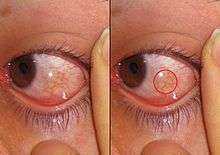Chemosis


Chemosis is the swelling (or edema) of the conjunctiva. It is due to exudation from abnormally permeable capillaries. In general, chemosis is a nonspecific sign of eye irritation. The outer surface covering appears to have fluid in it. The conjunctiva becomes swollen and gelatinous in appearance. Often, the eye area swells so much that the eyes become difficult or impossible to close fully.[1] Sometimes, it may also appear as if the eyeball has moved slightly backwards from the white part of the eye due to the fluid filled in the conjunctiva all over the eyes except the eyeball. The eyeball is not covered by this fluid and so it appears to be moved slightly inwards.
Causes
It is usually caused by allergies or viral infections, often inciting excessive eye rubbing. Chemosis is also included in the Chandler Classification system of orbital infections.
If chemosis has occurred due to excessive rubbing of the eye, the first aid to be given is a cold water wash for eyes.
Other causes of chemosis include:
- superior vena cava obstruction, accompanied by facial oedema.
- hyperthyroidism, associated with exophthalmos, periorbital puffiness, lid retraction, and lid lag.
- cavernous sinus thrombosis, associated with infection of the paranasal sinuses, proptosis, periorbital oedema, retinal haemorrhages, papilledema, extraocular movement abnormalities, and trigeminal nerve sensory loss.
- Carotid-cavernous fistula - classic triad of chemosis, pulsatile proptosis, and ocular bruit
- cluster headache
- trichinellosis
- Systemic lupus erythematosus (SLE)
- angioedema
- Acute glaucoma
- Panophthalmitis
- Orbital cellulitis
- Gonorrheal conjunctivitis
- Dacryocystitis
- Spitting cobra venom to the eye
- Urticaria
- Rhabdomyosarcoma of the orbit[2]
Treatment
Treatment depends on the cause of the chemosis.
References
- ↑ MedlinePlus Health Information from the National Library of Medicine
- ↑ Narang, G.S., Pahwa, J.S. Pediatric Oncall Child Health Care. Fungating orbital mass Question. 8 Feb 2011